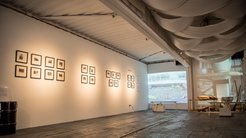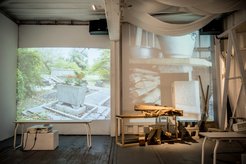Shinto Shrines in Taiwan 101: Art Exhibition in Kaohsiung, Taiwan
by Liza Wing Man Kam
‘Are there Shinto Shrines in Taiwan?’
Often when I spoke about my work on the Shinto Shrines in Taiwan, people ask, ‘Are there Shinto Shrines in Taiwan? I thought that’s Japanese.’ This is but not limited to the people outside Taiwan. This part of history in Taiwan as well as its connection to the rest of the East Asian region has been, if not opaque, at least vague—much to do with the so many different versions of narratives adopted/pronounced by different authorities across the straits and along the historical timeline.
Colonial/ post-colonial/ neo-colonial
Once the high symbolism of the colonial authority during the Japanese occupation between 1895-1945, Shinto Shrines, on top of their role being the religious space, had been widely built in Taiwan as tools to imbue Japanese nationalism in the colony. In the post-colonial era, such Shinto Shrine were either transformed into different forms to fit into a different/ essentially similar political agenda but by the new regime, or they ceased to exist.
In March, August, September 2017 and February, March 2018, Norman Tsai Jung-Jen and I went on our continual adventure exploring the 300+ Shinto Shrines which are left in Taiwan. Some of them are in or around the cities, but more are hidden on the mountains or in the forests.
During these field trips in Taiwan exploring the relics of Shinto Shrines, I observed the juxtaposition, and even total integration of such relics in the Taiwanese people's quotidian existence-- such normality embraced by the current Taiwanese society is however, from my perspective of being a researcher, not to be taken for granted.
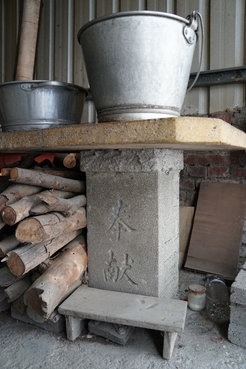
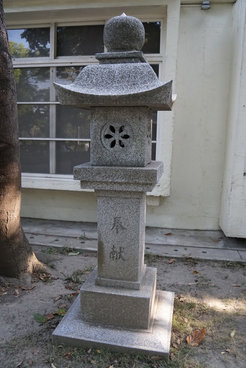
In March 2018, in one of the visits to the relics of the Jiadong Shrine in Pingtung in the south of Taiwan, seeing our rather ‘professional looking’ photo-shooting gadgets, a very pleasant elderly lady came to us and spoke to us. She spoke no words of Mandarin, but roughly I understood with my limited Taiwanese that she wanted to show us something at the back of her house—somewhere off the ‘Sandō’ (参道, the frontal approach towards the main chambers of Shinto Shrine after passing the ‘Tori-I’ (the gate separates the secular and the sacred). It was for her kitchen worktop: An image with such composition (Fig.1) displays the highest level of entanglements in so many different levels: The stone block engraved with the Japanese characters ‘ 奉献 ’ (means dedicated), once composed the bottom part of a stone lantern (Fig.2) usually placed to illuminate the ‘Sandō’, was now ‘beheaded’ and used to support her worktop for buckets and storage of wood. She knew that the piece was relics from the Japanese colonial era, and she knew that it was ‘heritage’. One might condemn her for being ignorant, in the first place, and think that she did not see the value of that ‘national treasure’. Here comes my question: since when that piece became ‘national treasure’? While it is comprehensible how the Chinese Republicans perceived of all these Shinto Shrines after they took over Taiwan from the hands of the ‘defected’ Japanese colonisers in 1945, one would imagine, a rapid act to eradicate the colonial related memorials should have been implemented immediately in 1945. This is but not the truth. A tough stance and determination to eliminate the colonial structures were not taken until 1974, almost three decades after the retrocession of Taiwan, and more importantly, three years after Japanese government decided to cut the official diplomatic ties with the Republic of China, Taiwan and established diplomatic relation with the People’s Republic of China. Considering the possibility of all these today’s ‘national treasures’ being totally annihilated during the 1970s, architectural conservationists should perhaps thank the lady for her active protection, ‘re-use’ or even ‘re-vitalisation’ of the heritage—the ‘national treasure’.
Shinto Shrines in Taiwan 101: Art Exhibition in Kaohsiung, Taiwan
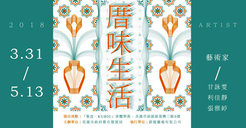
As a first step to understand, on the one hand, the colonial/ post-colonial power construction entangled in such settings, and on the other hand how Taiwanese folks incorporate with the at times sacred and at times symbol of evilness in their quotidian space—through photography and art installation, my art exhibition in Kaohsiung, Taiwan (01.04.18-13.05.18) aspired to observe the seemingly normal vernacular settings embraced by the Taiwanese folks. Ultimately it aspires me to reflect on how much Shintoism has in fact penetrated into the Taiwanese society (and lack thereof) by displaying how relics from Shinto Shrines, the 'religious' elements, are blended into the fabrics of everyday routine with people's endless creative input, as to form the non-official part of the narratives telling the stories of the last, current and next generations' Taiwan.
(Special thanks to Prof. Norman Tsai Jung-Jen, my research partner from the Department of Architecture at the National United University of Taiwan for his expertise on the subject and his endless support.)
